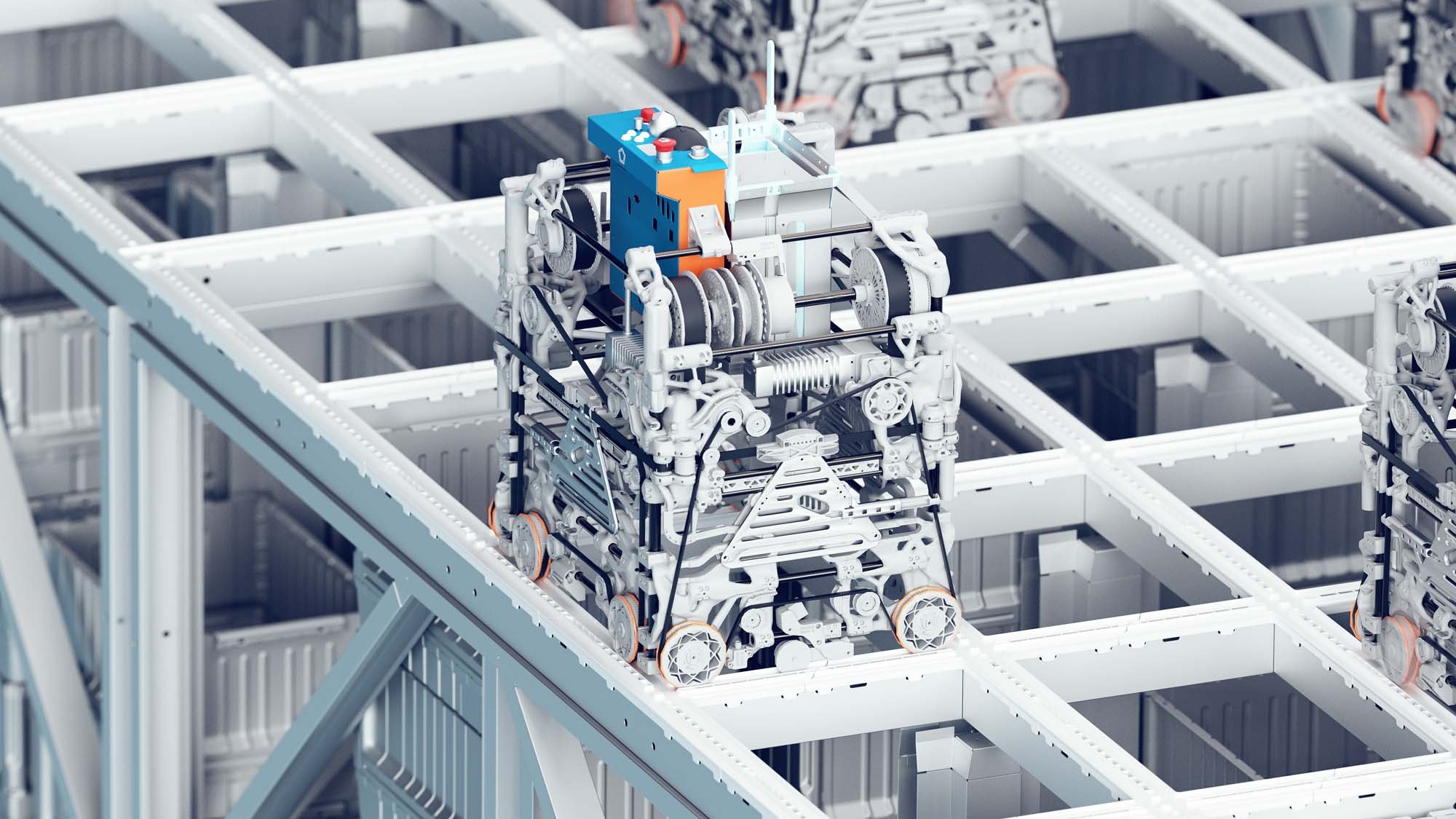The term warehouse robots, like warehouse automation, covers a broad range of technologies. This category includes both advanced modern robotics from companies like OIA and more traditional robotic automation systems, designed to automate specific, repetitive and non-productive tasks.
According to a report by Grand View Research, the global warehouse robotics market size was valued at $4.31bn in 2022 and is expected to grow at a compound annual growth rate (CAGR) of 19.6% from 2023 to 2030.
What’s the difference between traditional robots and modern robotics?
The key difference between traditional robotics and what we call ‘modern robotics’ is that the latter isn’t hardwired to do a single task: modern warehouse robots combine computer vision, sensors such as LiDAR; artificial intelligence (AI); and other nascent technologies to learn, adapt and interact with the world around them.
And while they’re physical, hardware devices, they’re defined by their software—which can be adapted and upgraded to give them new roles and capabilities as their applications grow.
Benefits of warehouse robots
A fundamental benefit of warehouse robots is the ability to perform tasks that humans can’t, or won’t. By using robots to handle challenging or repetitive tasks, businesses can create a safer and more efficient work environment for their employees.
From lifting entire pallets of heavy stock to performing the same task day after day with the same level of precision and efficiency, robots take a lot of the monotony and unwelcome effort out of warehouse work—enabling your employees to upskill and find more interesting roles.
Robots can also work through the night, during holidays, in very cold environments for long periods or when labor laws forbid it. And when things get really busy, such as on Black Friday, warehouse robots keep your employees’ workloads manageable, scaling up with more robots when needed.
For a more detailed breakdown of the benefits of warehouse automation, including warehouse robotics, read our 10 Real-World Warehouse Automation Benefits.
Types of warehouse robots
Robotics plays a key role in modern warehousing, with warehouse robots designed to perform various tasks. Some operate autonomously alongside humans, while others remain in designated areas, functioning as coordinated swarms controlled by central software. Here are the main types of warehouse robots in active service today:
Automated Guided Vehicles (AGVs)
AGVs are mobile robots that navigate predefined paths within a warehouse, transporting goods or materials between various locations. They typically follow magnetic strips, wires, or markers on the floor.
AGVs have been around for a while now, and don’t typically employ as cutting-edge technology as other modern robotics. As a result, they’re typically used to perform repetitive, fixed-path tasks such as transporting goods from one point to another.
AGVs are rarely designed to interact with human workers and are less flexible in dynamic environments as they require predefined paths—making any layout changes in the warehouse necessitate reconfiguration of their navigation paths.
The majority of AGVs on the market are goods to person (GTP) solutions, working alongside a robotic arm, vertical lift or other payload handling solution.
Best For: Repetitive, fixed-path tasks in controlled environments.
Autonomous Mobile Robots (AMRs)

AMRs are mobile robots similar to AGVs, yet equipped with advanced sensors and obstacle avoidance systems that enable them to navigate dynamically in complex environments. Unlike AGVs, AMRs employ advanced software-based programming—often using machine learning (ML)—to easily learn and adapt to new workflows and layouts without the need for physical magnetic strips or tracks.
AMRs are designed to integrate seamlessly with existing warehouse systems and infrastructure, working safely alongside human pickers. While AMRs are also predominantly goods to person (GTP) solutions, some use a person to goods (PTG) model to guide or follow employees to the correct picking location.
Ocado Intelligent Automation’s Chuck AMR solution is a PTG AMR solution designed for rapid deployment, boosting productivity by assisting workers in picking items, reducing travel time, and optimizing routes. It’s especially suited to low to medium throughput retail and logistics/3PL as well as any application with a large variety of physical SKU sizes..
A key benefit for AMRs is how quickly they can be deployed and integrated into your warehouse, working alongside your human operators. Employees can be trained to take full advantage of an AMR’s benefits within minutes.
Best For: Dynamic and complex warehouse environments with frequent layout changes.
Robotic Arms
Robotic arms are highly versatile warehouse robots capable of picking, packing, palletizing, and sorting items in a warehouse. Arms can be fixed in place or mounted on mobile platforms for greater maneuverability. Sometimes called robotic manipulators, robotic arms use advanced end-of-arm tooling (EoAT) to pick up and handle items.
We’ve all seen how large robotic arms can be in manufacturing—manipulating entire car frames in automotive applications. In warehouses, robotic arms vary in size from large arms used for lifting pallets or palletizing and depalletizing stock to much smaller arms designed to perform delicate tasks such as moving fragile items without damaging them.
OIA’s Robotic Pick solution places robotic arm-based picking robots directly on top of the OSRS grid, enabling stock items to be picked directly from bins. Robotic Pick uses AI to identify items, locate their edges and learn how best to grasp and handle them without prior knowledge. Its bespoke end effector, a type of EoAT using a high-pressure vacuum, enables Robotic Pick to pick up and manipulate very delicate items such as groceries.
Best For: Precise, versatile tasks such as picking, packing, palletizing, and sorting.
Sortation Robots
Sortation or sorting warehouse robots generally use a robotic arm to segregate and organize items based on predefined criteria such as size, shape, or destination. Capable of handling large volumes of items quickly and accurately, sorting robots streamline the sorting process in warehouses and distribution centers.
By automating the sorting tasks, these robots reduce reliance on human labor and improve the speed and accuracy of sorting operations, contributing to a more efficient supply chain.
Parcel sortation robots are specialized in sorting packages and parcels for distribution (for example, in a mail handling center). This includes items packaged by a retailer as well as items packed by humans at home, so they must be capable of handling a huge range of shapes, sizes and materials.
OIA’s Robotic Sort robot is a robotic-arm based sortation solution, capable of handling a range of merchandise securely yet delicately, including deformables such as polybagged items.
Powered by AI, Robotic Sort collaborates with humans, improving employee engagement and experience while increasing overall productivity. After identifying merchandise visually, Robotic Sort lifts and manipulates the item to locate a barcode—then stows it in the correct put-wall bin ready for picking and order completion by human operators.
Productivity and efficiency increases over time as the robot learns from the items it handles, with learnings and adaptations shared automatically between robots.
Best For: Segregating and organizing items quickly and accurately based on predefined criteria.
ASRS Robots

While other types of ASRS may employ robotic elements, cubic ASRS goes further in using potentially thousands of individual mobile warehouse robots, moving together across a huge grid. These robots are not autonomous themselves—they’re orchestrated by an all-seeing Warehouse Execution System (WES), which guides robots to stock bins or tasks them with bin digging to retrieve bins lower in the grid and deliver them to a pick station.
As a GTP solution, cubic ASRS is particularly beneficial in environments where space is at a premium, as it allows for high-density vertical storage of a huge range of stock within a cube or grid, and rapid retrieval of items to human pick stations, significantly enhancing overall warehouse productivity.
The Ocado Storage and Retrieval System (OSRS) is an ultra-high-density cubic storage and retrieval system combining world-proven automation with business intelligence. Powered by our smart Warehouse Execution System (WES) software, this cutting-edge ASRS has been designed to answer high-throughput, high-density applications in a wide range of industries and use cases.
Best For: High-throughput storage and automated GTP retrieval of a wide range of SKUs.
Warehouse Drones

While we’ve yet to see drones used to manipulate stock directly, drones are increasingly being used for inventory management and warehouse monitoring tasks. They can fly overhead to scan barcodes, track inventory levels, and identify potential issues in real-time.
Drone warehouse robots offer operators a bird's-eye view of the warehouse, allowing for quick and accurate inventory audits and monitoring of storage conditions, reducing the time and effort required for manual inventory checks.
Best For: Inventory management and warehouse monitoring tasks.
What to consider when exploring warehouse robotics solutions
Integrating robotics into your warehouse is a transformative step, demanding thorough analysis and strategic thinking to ensure you select the right solutions for your business, your customers, and your current workforce. Here are some things to keep in mind:
Your current challenges
Selecting the right type of warehouse robot begins with assessing your operational needs and current shortfalls. What do you need warehouse robotics to solve?
Growth projections
Any organization looking to invest must consider its needs now and in 10+ years. While the innate scalability of modern robotics means it’s now far less likely that automation will become the bottleneck in the future, it’s important to consider the journey; for example, will an AMR solution enable you to hit the ground running today, and then move to a full-scale cubic ASRS in the future?
Initial investment vs long-term savings
It’s difficult to calculate the ROI of any automation solution due to the sheer number of variables involved. The capex involved can vary massively—AGVs sit at the cheaper end of the spectrum, while a cubic ASRS comes with a large initial investment. However, the potential for long-term savings with a more fulsome warehouse robotics solution is significant due to the increase in throughput and accuracy.
Integration with existing systems
Warehouse robots vary in their level of independent autonomy; some, such as Chuck AMR, can operate entirely autonomously as a single unit. Others, like the robots found in a cubic ASRS solution, must function as part of a ‘hive’—working together, orchestrated by a WES. Regardless of their individual autonomy, these robots are designed to function as part of a larger environment—the warehouse itself. The Warehouse Management System (WMS) oversees all aspects of the warehouse, from inbound logistics to lighting. When evaluating a robotics solution, it’s crucial to consider how it will integrate with the WMS and other existing systems.
The right vendor
The right vendor is crucial when implementing warehouse robotics, as it directly impacts the long-term success of the integration. Select a vendor capable of sustaining a long-term partnership—one that invests heavily in R&D to ensure your operation has a continuous improvement path ahead. In addition, a reputable vendor will provide reliable, high-quality technology and also offer comprehensive training and/or ongoing support and maintenance. Proper training ensures that your team can effectively operate and maintain the robots, while support and maintenance ensures any issues are addressed quickly, minimizing downtime. If you’re considering an AMR or ASRS solution, talk to us. With over 20 years of experience developing and operating our own warehouse robotics equipment, leading brands trust Ocado as their robotics solutions provider to automate and accelerate their businesses. We also offer ongoing maintenance packages, including 24/7 service with an on-site engineering team that handles all engineering tasks.
Trends in warehouse robotics
Warehouse robots are becoming smarter, more flexible, and more capable of working alongside humans. Here are some key trends we see shaping the future of warehouse robotics and how they’re transforming operations:
AI and Machine Learning (ML)
As they are in every corner of industry, AI and Machine Learning are increasingly central to warehouse robotics. AI enables systems to adapt, optimize, and predict in real time, enhancing a warehouse robots' ability to make data-driven decisions, improving efficiency and accuracy in tasks like inventory management, order picking, and predictive maintenance. As warehouses become more complex, AI will ensure operations remain agile and scalable.
Hybrid systems
A growing number of warehouse robotics solutions on the market today can be described as hybrid systems. Hybrid systems combine two or more of the above robots into a single system that can perform multiple warehousing tasks. For example, some hybrid systems on the market combine shuttles with picking robots for rapid ground-level transportation.
Examples of hybrid systems might include AMRs with built-in vertical lifts, or robotic arms picking within an ASRS. Within OSRS, our robotic pick solution employs a robotic arm to pick directly on top of the grid, providing a hybrid picking solution that can significantly reduce the time required to pick customer orders.
Meeting labor challenges
The warehouse and fulfillment industry is facing ever-tougher labor challenges, including worker shortages, high turnover rates, and the need to scale operations during seasonal peaks. Recruiting and retaining skilled workers is increasingly difficult, especially when demand spikes and seasonal labor force is required. Robotics offers a solution by automating repetitive and physically demanding tasks, reducing reliance on human labor while enabling your employees to perform potentially more meaningful and interesting tasks. During peak seasons, robots can quickly scale operations, handling increased workloads without the need for additional temporary staff. This not only alleviates labor shortages but also improves efficiency and accuracy. By filling in gaps and ensuring consistent performance, robotics helps warehouses meet demand and maintain productivity year-round.
Cobots offer greater collaboration
Humans play a vital role in any warehouse environment, and many of today’s robots operate in close proximity to your workforce. Collaborative robots, or ‘cobots’, assist workers with tasks such as picking, packing, and inventory management. Functional safety, being a system’s ability to detect, diagnose, and safely mitigate the occurrence of any fault, preventing harm to people and the environment, is critical for any robot deployed in proximity to humans.
While not all AMRs are cobots, OIA’s Chuck AMR is designed to work alongside and assist human operators. All of OIA’s technology conforms to the IEC61508 functional safety standard, designed to enable robots to work in direct proximity to humans, without the need to be isolated within metal cages to distance them from their surroundings and from people.
Warehouse robots enable organizations to future-proof their warehouse operations
Modern warehouse robotics encompasses a range of advanced technologies, centered around intelligence and sensor-based technologies that enable robots to act and react more naturally than ever.
These systems enhance efficiency, scalability, and accuracy in warehouse operations, addressing challenges like labor shortages and seasonal demand spikes. When selecting a robotics solution, consider your current needs, future growth, integration with existing systems, and long-term ROI. To find the right solution for your business now and into the future, speak with our experts today.
Want To Learn More?
Our expert team is ready to discuss your unique requirements and provide a customized solution that revolutionizes your fulfillment operations.
@4x.png?width=642&height=166&name=OIA_Logomark_color_(R)@4x.png)





